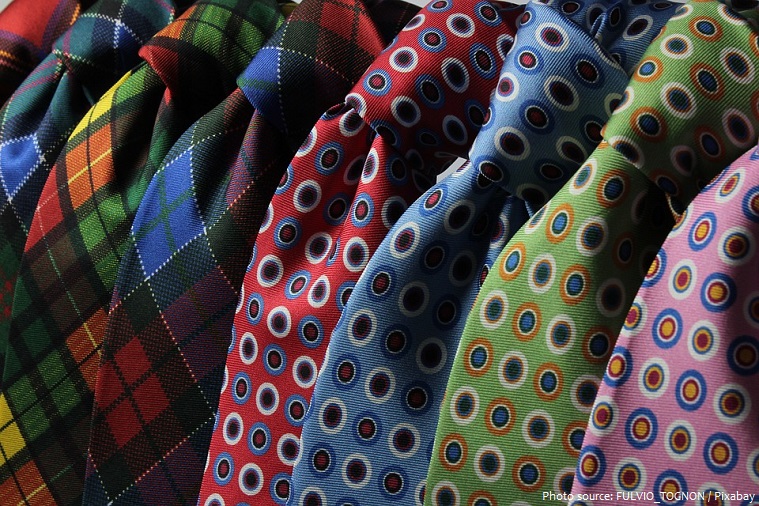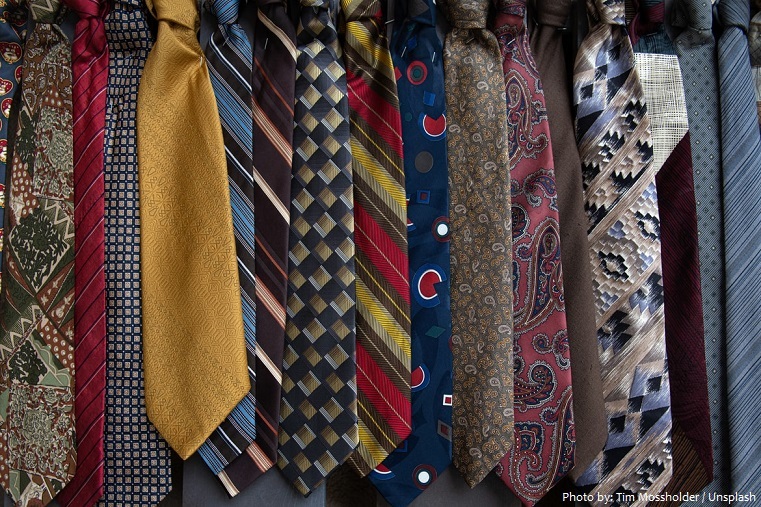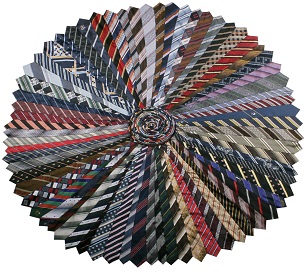
A necktie, or simply a tie, is a piece of cloth for decorative purposes around the neck, resting under the shirt collar and knotted at the throat, and often draped down the chest.
Variants include the ascot, bow, bolo, zipper tie, cravat, and knit.
The modern necktie, ascot, and bow tie are descended from the cravat. Neckties are generally unsized, but may be available in a longer size.
There are four main knots used to knot neckties. In rising order of difficulty, they are:
• the four-in-hand knot. The four-in-hand knot may be the most common.
• the Pratt knot (the Shelby knot)
• the half-Windsor knot
• the Windsor knot (also redundantly called the “full Windsor” and the “Double Windsor”).

The necktie that spread from Europe traces back to Croatian mercenaries serving in France during the Thirty Years’ War (1618–1648). These mercenaries from the Military Frontier, wearing their traditional small, knotted neckerchiefs, aroused the interest of the Parisians. Because of the difference between the Croatian word for Croats, Hrvati, and the French word, Croates, the garment gained the name cravat (cravate in French).
The boy-king Louis XIV began wearing a lace cravat around 1646, when he was seven, and set the fashion for French nobility. This new article of clothing started a fashion craze in Europe – both men and women wore pieces of fabric around their necks. From its introduction by the French king, men wore lace cravats, or jabots, that took a large amount of time and effort to arrange. These cravats were often tied in place by cravat strings, arranged neatly and tied in a bow.

The early cravats of the 17th century have little resemblance to today’s necktie, yet it was a style that stayed popular throughout Europe for over 200 years.
These early cravats were purely decorative pieces of cloth that were made from finest and most elaborately decorated fabrics. The looks of these early ties resemble more bowties rather than a modern necktie.
With the industrial revolution, more people wanted neckwear that was easy to put on, was comfortable, and would last an entire workday. Neckties were designed to be long, thin and easy to knot, without accidentally coming undone. This is the necktie design still worn by millions.

By this time, the sometimes complicated array of knots and styles of neckwear gave way to neckties and bow ties, the latter a much smaller, more convenient version of the cravat. Another type of neckwear, the ascot tie, was considered de rigueur for male guests at formal dinners and male spectators at races. These ascots had wide flaps that were crossed and pinned together on the chest.
In 1922, a New York tie maker, Jesse Langsdorf, came up with a method of cutting the fabric on the bias and sewing it in three segments. This technique improved elasticity and facilitated the fabric’s return to its original shape. Since that time, most men have worn the “Langsdorf” tie. Yet another development during that time was the method used to secure the lining and interlining (known as the swan) once the tie had been folded into shape. Richard Atkinson and Company of Belfast claim to have introduced the slipstitch for this purpose in the late 1920s.

During the Art Deco movement of the 1930s, neckties became wider and often displayed bold Art Deco patterns and designs. Men also wore their ties a bit shorter and commonly tied them with a Windsor knot – a tie knot that the Duke of Windsor invented during this time.
The early part of the 1940s didn’t offer any exciting change in the world of men’s ties – possibly an effect of WWII which had people worry about more important things than clothing and fashion. When WWII ended in 1945 however, a feeling of liberation became evident in design and fashion. Colors on ties became bold, patterns stood out, and one retailer by the name of Grover Chain Shirt Shop even created a necktie collection displaying sparsely dressed women.
When talking about ties, the 1950s are most famous for the emergence of the skinny tie – a style designed to compliment the more form fitting and tailored clothes of the time. Additionally tie makers started experimenting with different materials.

The 1960s brought about an influx of pop art influenced designs. The first was designed by Michael Fish when he worked at Turnbull & Asser, and was introduced in Britain in 1965. The exuberance of the styles of the late 1960s and early 1970s gradually gave way to more restrained designs. Ties became wider, sometimes with garish colors and designs.
The disco movement of the 1970s truly embraced the ultra wide “Kipper Tie”. But also worth noting is the creation of the Bolo Tie (aka Western Tie) which became Arizona’s official state neckwear in 1971.
The 1980s, 1990s and Noughties saw further iterations of the tie. Along with the two and three-piece suit, it is affected by the times. Whatever is going on culturally, economically and sociologically it eventually is reflected in the clothes and accessories we wear. For those over 40, you will no doubt remember the very many ties from your past. For such a small piece of cloth – the changes have been considerable.

Today, ties are available in many widths, cuts, fabrics, and patterns. It is all about choice and allowing the modern man to express his own personal style.
The most expensive necktie in the world is a product of the Satya Paul Design Studio and the Suashish Diamond Group, who teamed up to bedazzle a necktie with almost $220,000 worth of diamonds, along with 150 grams of gold used for its pattern, and 271 diamonds with a total weight of 77 carats.
The most neckties tied with a four-in-hand knot in one minute are 13 and were achieved by Yu Zhenzhen (China) on the set of Zheng Da Zong Yi – Guinness World Records Special in Beijing, China, on 14 November 2008.
The most neckties tied simultaneously is 1,103, by attendees of the 2014 Ohio DECA Career Development Conference organized by Ohio DECA (USA), in Columbus, Ohio, USA, on 14 March 2014.
A neck tie measuring 808 m (2,650 ft) was made by members of the Academia Cravatica organisation. It took five days to complete and was tied around the arena in Pula, Croatia on 18 October 2003. Widest part – 25 m. Narrowest part – 8 m.
International Necktie Day is celebrated on October 18 in Croatia and in various cities around the world, including in Dublin, Tübingen, Como, Tokyo, Sydney and other towns.
